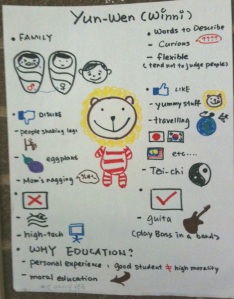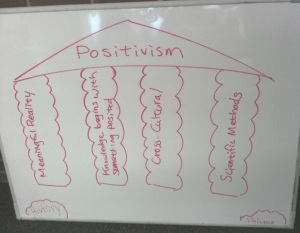The Intro Astro 3 – Fall 2011
Hey… didn’t we have a good time with the Gallery activity?! We turned our space into a gallery of representation. I don’t know about you… but I really felt the tension. Again I say that it is a heck of a thing to represent someone. Many of you interpreted the assignment and did some creative things. We saw several true works of art. After looking at the questions in the gallery guide while looking at one another’s’ representations, we talked about the representation first with the dyads and then in small groups and then as a large group. We discussed how we felt about representing and being represented.
How can we say that the person is truly like this? How do you position yourself as a researcher when you represent others? I was happy to see the diversity of the ways you choose to represent others. How does it feel to be represented in a particular way?
We started to talk about member checks. We will talk more about this when we get to the notion of validity in qualitative research. The accuracy of a portrait and the notion of consequence are important. Some of the consequences are minor but some are big. Later on, we’ll talk about “member checks” as a way to increase the validity of your representation. Note that there are numbers of reasons that may get you thinking that you may not want to do member checks).
Another thing is “properlining.” People properline when they feel a bit insecure or at risk. Basically they say what they think you want to hear. I gave the example of my wife who, when I turned on a tape recorder suddenly changed in her tone and manner of speech.
We also noted the trust is a major issue in research.
Concept Map Activity
As an activity I asked everyone to draw a concept map of positivism. I asked you to think about the research process and the role of researcher and the researched when you do this. Then, contrast that with a visualization. Before this we had looked at the Periodic Table of Visualization Methods. This got us thinking about the representation of ideas visually. A concept map creates an abstract depiction of a concept.
Then in groups I asked you to create concept maps of both Positivism and Constructionism. This is not so easy but you came up with some really great, thought provoking contributions. I’m sorry that we didn’t get to all of them. We will go over them a bit more next time. There are images of all of them on Learn@UW. We also posted images of the representations there as well.
On one of the Maxwell slides there were indicated four main sources for conceptual frameworks: experiential knowledge; existing theory and research; pilot study; and thought experiments/ think-up theory (ex: Einstein, Marx). Einstein used ingenious thought experiential to explore the consequences of movement that approaches the speed of light. This helped him to conceive his now famous theory of relativity. Freud and Marx used theories that were generally “think up” theories. I mean that they did not derive from very systematic research but were very powerful theories nonetheless that are sill profoundly influential.
Someone asked, “Do people ever switch their Conceptual Framework in the middle of their research?” I said, “Heck yeah! It happens ALL THE TIME.” I then launched into an admittedly self indulgent autobiographical story. During my dissertation work I had two advisors because I was a double major doctoral student. One of my advisors was really into “Activity Theory” for a while and urged me to use it in my analysis of technology implementation in schools. Well… I did lots of reading about it and I was really “gung ho!” But…. when I tried to explain it to my other advisor… he didn’t understand it and asked me to clarify. Alas! I COULDN’T!!! He laughed and so did I sheepishly. Long story short… I dropped it and then everything went well with my study. Activity Theory in this case was a fifth wheel. I simply didn’t need it.
Next time we are going to get into some fun stuff. We will explore Critical Theory and Postmodernism. We will also do more on interpretivism that we didn’t really talk about enough in class.
I wanted to say “Thanks” to all of you who wrote something in our little exit surveys. I find this very useful. It is a way for us to think about what we’re doing in class and well or how poorly we might be doing. I very much appreciate your comments and suggestions!
And remember…. Do “Quality” work!
Posted on 09/29/2011, in Introduction to Qualitative Research. Bookmark the permalink. Leave a comment.




Leave a comment
Comments 0